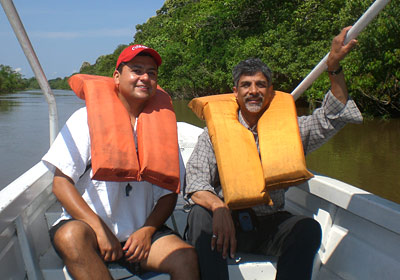The search for 'green' gold in the Amazon rain forest
By Sheri Hall

In a hunt for plants in the Amazon rain forest that have potential to be used for sustainable light-weight construction beams, electronic cases or other high-performance materials, Cornell fiber science professors Anil Netravali and Juan Hinestroza are forging new collaborations with researchers in Brazil.
"The Amazon is incredibly rich in plant species that provide unique challenges to materials chemistry," Hinestroza said. "Some of these fiber-producing plants have extraordinary properties that could be harnessed to produce high-performance materials in a truly sustainable fashion."
Netravali and Hinestroza, both in the Department of Fiber Science & Apparel Design in Cornell's College of Human Ecology, delivered keynote speeches on the Amazon's green materials during an August meeting organized by the Universidade Federal do Amazonas in Manaus, Brazil. The city is in the middle of the Amazon jungle where the Rio Negro and Rio Solimoes merge to create the Amazon River.
The meeting brought researchers together to explore new ways to improve the mechanical and chemical properties of natural native materials and use them in structural and high-performance applications.
Hinestroza presented his work on self-assembly of polymers and nanoparticles -- essentially where tiny components form an organized pattern -- at the interface between natural and synthetic materials. He also gave a talk on new chemical pathways to increase the functionality of natural fibers.
Hinestroza and collaborators from eight universities are also working to establish a network of investigators across Latin America to explore using novel cellulosic and lignocellulosic substrates from plants that only grow in the jungles of the Brazilian Amazon and the forests of Colombia. The network of researchers will also explore using natural silicate platelets that are only available in the volcanoes of Mexico and the deserts of Chile. These materials have potential use as reinforcements for composites exhibiting ballistic protection, fire retardancy, acoustic insulating and any other high-performance properties, Hinestroza said.
Netravali presented his pioneering research on biodegradable "green" composites made entirely from plant fiber and a resin derived from soy protein. They are much more environmentally friendly than traditional composites, which are typically made of petroleum-based products and can't be reused or broken down at the end of their life cycle.
In addition, researchers from Brazilian universities showcased the use of sisal and other native fiber-producing plants in the reinforcement of concrete structures as well as other examples of sustainable engineering, including the construction of a 100 percent sustainable ecological town in the middle of the Amazon rain forest.
"Brazil and particularly the Amazon rain forest are blessed with an amazing variety of plants and provide a great opportunity to collaborate on research on green and sustainable materials," Netravali said. "I am excited and look forward to working with the Brazilian researchers who are keen in efficient use of this huge natural resource they have."
Sheri Hall is assistant director of communications at the College of Human Ecology.
Media Contact
Get Cornell news delivered right to your inbox.
Subscribe